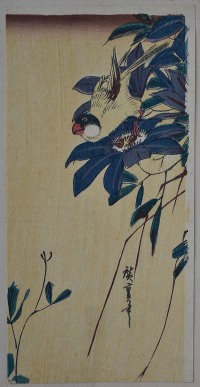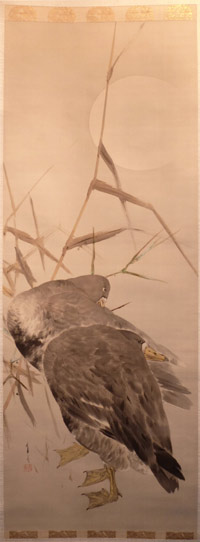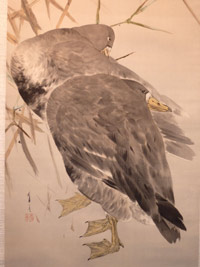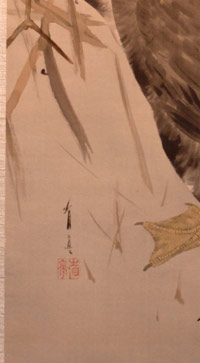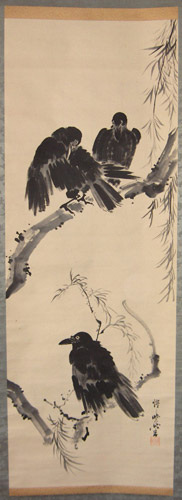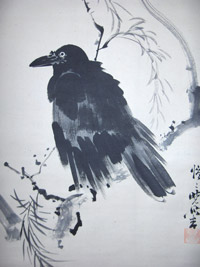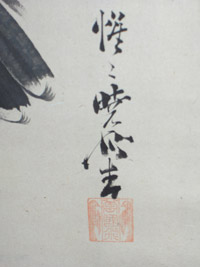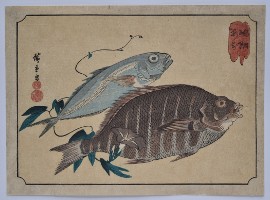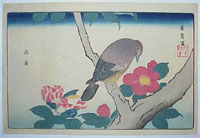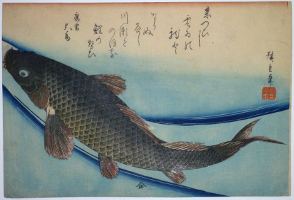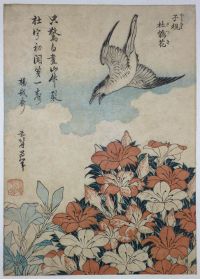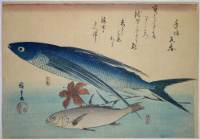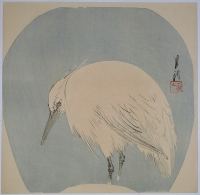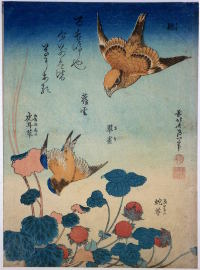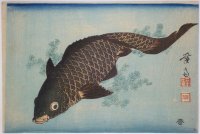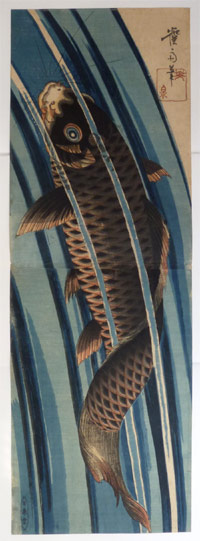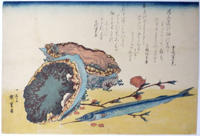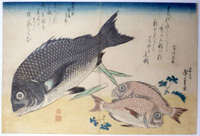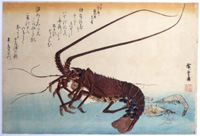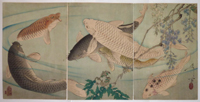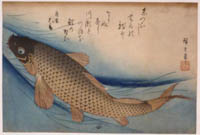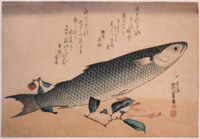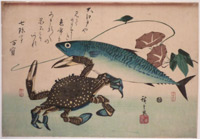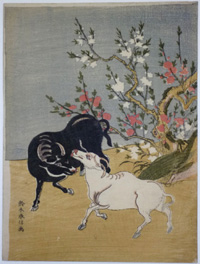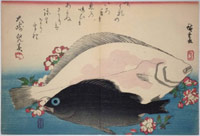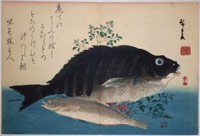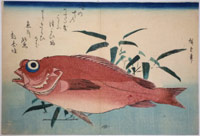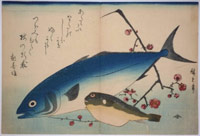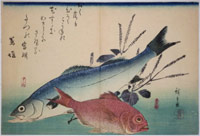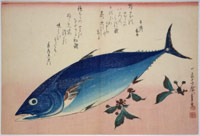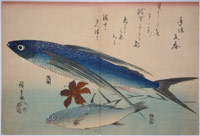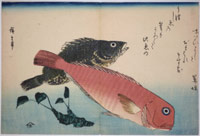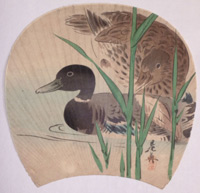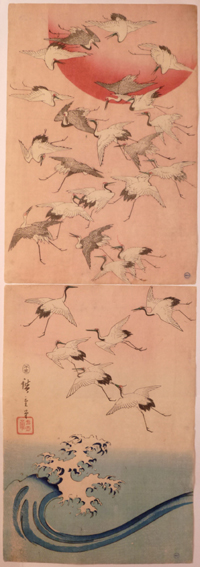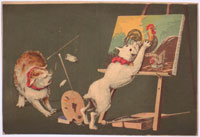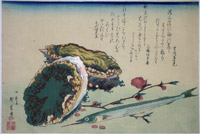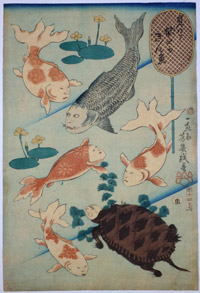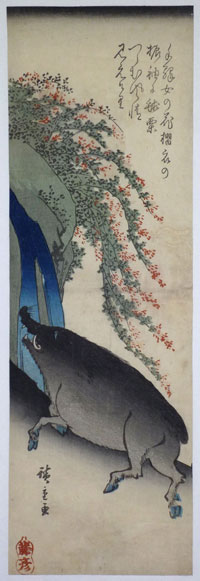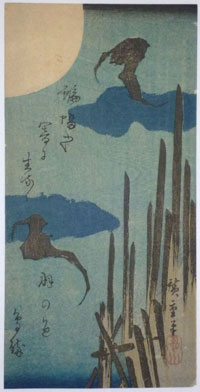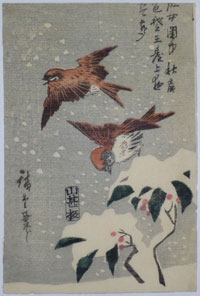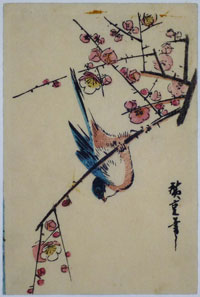Utagawa HIROSHIGE (1797-1858)
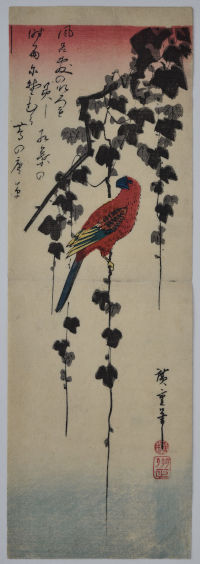
Click here to view image full size.
A tanzaku showing a parrot perched on hanging ivy. Published c 1830s by Kawasho (Kawaguchi Shozo).
Fine impression and colour. Centre fold, otherwise very good condition. Signed Hiroshige hitsu.
Status: Sold
Utagawa HIROSHIGE (1797-1858)
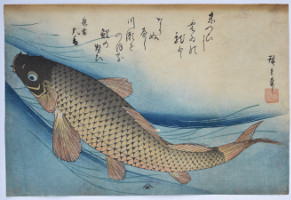
Click here to view image full size.
A koi, carp (Cyprinus carpio) swimming amongst reeds. Poem by Makuzu. From the second series of ten fish prints published by Yamasho, c. 1840-42. The first series was issued privately for a poetry group (probably the Shingyoku Circle) with judges’ names and with extra poems. These prints are of the utmost rarity as probably only enough for the Circle were made and they never come onto the market. Due to their popularity this second set was commissioned. This is the very rare first edition with the reeds printed. Block defect showing but with gradation still on belly of fish. One of the finest designs from the two series. Very rare. Kruml 12a/b.
Fine impression. Slight fading and edge soil, otherwise very good condition. Without centre fold (in itself rare as they often have them). Signed Hiroshige hitsu.
Status: Sold
Utagawa HIROSHIGE (1797-1858)
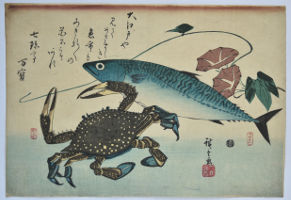
Click here to view image full size.
A kami, crab (Charybois), and saba, mackerel (Scomber Japonicus), together with two flowers of morning glory. Poem by Shichichintei. This is the first edition (Kruml 19a). From the second series of ten fish prints published by Yamasho, c. 1840-42. The first series was issued privately for a poetry group (probably the Shingyoku Circle) with judges’ names and with extra poems. These prints are of the utmost rarity as probably only enough for the Circle were made and they never come onto the market. Due to their popularity this second set was commissioned.
Fine impression, colour and condition. Signed Hiroshige ga.
Status: Sold
Ichiryusai HIROSHIGE (1797-1858)
Click here to view image full size.
A Java sparrow on a clematis vine. A sanchogake format (three designs printed on a horizontal sheet and intended to be separated). Published c 1835-9. Rare.
Very good impression, colour and condition. Signed Hiroshige hitsu. (There is an impression with a cube-shaped red Hiroshige seal which is the first state.)
Status: Sold
Watanabe SEITEI (1851-1918)
Click here to view image full size.
Two geese – possibly Greater White-fronted Geese ( although the legs should be a little more orange ) with tall reeds and a large misty moon. Sumi and light colour on silk, 43 x 16 in; 109 x 40.5 cms. Signed and sealed Seitei. In fine condition with original box signed and sealed by Seitei.
Status: Sold
Kawanabe KYOSAI (1831-1889)
Click here to view image full size.
A fine painting, sumi on paper, showing three crows on the boughs of a willow tree. Crows were one of Kyosai’s favourite subjects and, apart from paintings, he used them in various formats: fan prints, oban and dai-oban prints. There are also numerous copies of his crow paintings. Signed Kyosai ga. 51 x 18.5 inches, 129.5 x 47 cms. Very good condition with original mount and rollers.
Status: Sold
Ichiryusai HIROSHIGE (1797-1858)
Click here to view image full size.
An extremely rare aiban print showing a shimadai, grouper, (probably Chilodactylus zonatus) and an aji, horse-mackerel, (Caranx trachurus). From a set of eight prints of various fish published c. late 1830s.
Fine impression and colour. Slight soil, otherwise very good condition. Signed Hiroshige ga.
Status: Sold
Kitao MASAYOSHI (1764-1824)
Click here to view image full size.
A falcon and camellia. One design from the album: Kaihaku raikin zui, A Compendium of Pictures of Birds Imported from Overseas. The first edition published by Gungyokudo Matsumoto Zembei, 2/1789. Copies of the first two editions are excessively rare and it was then reissued with the plates signed Keisai (as here). However this print does not appear to be from an album and judging from the quality of printing must be from the first printing with signature and when some prints were issued separately. Designs that appear on the market from this publication are invariably on thin paper and poor impressions.
Fine impression with beautiful gradation and blind printing. On thick deluxe hosho Fine colour. Very minor soil, otherwise fine condition. Signed Keisai Utsusu.
Status: Sold
Ichiryusai HIROSHIGE (1797-1858)
Click here to view image full size.
Koi, carp (Cyprinus carpio) from the second series of ten fish prints published by Yamasho, c 1840-42. The first series was issued privately for a poetry group ( probably the Shingyoku Circle ) with judges’ names and extra poems. Poem above by Makuzu. These prints are of the utmost rarity as probably only enough for the Circle were printed and they never come onto the market. Due to their popularity this first series was published commercially and a second set was commissioned. The best design from the second set. Other examples: Vignier and Inada, Vol. VI, pl. LXIX, no. 265 and Tamba, no. 424.
Very good impression. Early state: See Andon 49, Hiroshige: A shoal of red herrings, number 12. This is Kruml c with the b Ichiryusai seal. Fine colour. Slight trimming left and top, otherwise very good condition. Signed Hiroshige hitsu.
Status: Sold
Katsushika HOKUSAI (1760-1849)
Click here to view image full size.
Cuckoo and azaleas from the so-called Small Flower series of ten chuban prints published c 1832. Amongst the most sought after of Hokusai’s prints. The first edition was published by and has the seal Eijudo. A later edition (as here) has combined manji and kiwame seal ( and some are printed on thin Chinese-style paper ), and there are also impressions extant without any seals which probably constitute a third state. All impressions are rare and the first state excessively so. Indeed, these prints are considered even rarer than the larger bird and flower set Hokusai designed c 1833. The printing and colour on this set comes close to surimono quality. Each print has a Chinese poem written in hiragana.
Fine impression. Slight fading, otherwise very good condition. Signed Zen Hokusai Iitsu hitsu.
Status: Sold
Ichiryusai HIROSHIGE (1797-1858)
Click here to view image full size.
Tobiuo, flying fish (probably Prognichthys) and ishimochi also called guchi or shiroguchi, white croaker, (probably Argyrosomus argenatus). Together with a single lily. Poem by Toshigaki Maharu. From the second series of ten fish prints published by Yamasho, c1840-42.The first series was issued privately for a poetry group ( probably the Shingyoku Circle ) with judges’ names and extra poems. These prints are of the utmost rarity as probably only enough for the Circle were printed and they never come onto the market. Due to their popularity this first series was published commercially and a second set was commissioned.
Fine, early impression with mica on the flying fish. Fine colour and condition. Full size and no centre fold. Signed Hiroshige ga in blue (which I have never seen).
Status: Sold
Ogata GEKKO (1859-1920)
Click here to view image full size.
An uncut fan print showing a great white egret. Rare.
Fine impression, colour and condition. Signed Gekko.
Status: Sold
Katsushika HOKUSAI ( 1760-1849 )
Click here to view image full size.
Shrike and wild strawberry from the so-called Small Flower series of ten chuban prints published c 1832. Amongst the most sought- after of Hokusai’s prints. The first edition ( as here ) was published by and has the seal Eijudo. A later edition has combined manji and kiwame seal ( and some are printed on thin Chinese-style paper ), and there are also impressions extant without any seals which probably constitute a third state. All impressions are rare and the first state excessively so. Indeed, these prints are considered even rarer than the larger bird and flower set Hokusai designed c 1833. The printing and colour on this set comes close to surimono quality. Each print has a Chinese poem written in hiragana.
Fine impression and colour. Minor soil, otherwise very good condition. Signed Zen Hokusai Iitsu hitsu.
Status: Sold
Keisai EISEN ( 1790-1848 )
Click here to view image full size.
A prolific pupil of Eizan. Shows a carp swimming among water-weed. Blue ground. An extremely rare print. Published by Ezakiya, c 1843-6. There is another version of this print without censor’s seal and with a moon reflected in the water. This appears to be a copy of the impression offered here as the blocks vary slightly. Ex Vever collection, Sothebys 1977, Part III, lot 227, p. 120 ( who also sold the copy, lot 228 ).
Fine impression, colour and condition. Signed Keisai.
Status: Sold
Keisai EISEN (1790-1848)
Click here to view image full size.
A vertical diptych of a carp leaping a waterfall. Published by Kansendo, c 1830 – 44. Illustrated Keisai Eisen: Artist of the Floating World, Chiba City Museum of Art, 2012, p. 240, pl. 313.
Very good impression, colour and condition. This was a popular design and later impressions are common. Signed Keisai hitsu with large red artist’s seal Eisen.
Status: Sold
Ichiryusai HIROSHIGE (1797-1858)
Click here to view image full size.
Awabe or tokobushi, abalone or “sea-ear” ( Haliotus tuberculata ) and sayori, Japanese half-beak or snioe-fish ( Hemirhamphus sayori ), Together with peach blossom. Poems by Kumogaki Fujimi and Miwagaki Mimiki. From the first series of ten plus one prints published by Eijudo c. 1832-34. The set was issued privately for a poetry group ( probably the Shingyoku Circle ) with judges’ names and extra poems. These prints are of the utmost rarity as probably only enough for the Circle were printed and they never come onto the market. Extremely rare early state before the kiwame and large Eijudo seal. Kruml a/b
Fine impression, colour and condition. Signed Ichiyusai Hiroshige ga.
Status: Sold
Ichiryusai HIROSHIGE (1797-1858)
Click here to view image full size.
Kurodai, black sea bream ( Acantho pagus schlegeli ) and akadai, red bream ( Pagus tumifrons ) together with bamboo shoots and Japanese pepper. Poems by Tomigaki Uchiyasu and Kaoan Hoshi.. From the first series of ten plus one prints published by Eijudo c. 1832-34. The set was issued privately for a poetry group ( probably the Shingyoku Circle ) with judges’ names and extra poems. These prints are of the utmost rarity as probably only enough for the Circle were printed and they never come onto the market.
Fine, early impression before the grey block defect on the tail of the black sea bream. Full size. Kruml 10b. Signed Ichiyusai Hiroshige.
Status: Sold
Ichiryusai HIROSHIGE (1797-1858)
Click here to view image full size.
Ise-ebi, spiny lobster or crawfish ( family Panulirus ) and shiba-ebi, shrimps. Poems by Ryokujuen Motoari and Toshihiro Machikado. From the first series of ten plus one prints published by Eijudo c. 1832-34. The set was issued privately for a poetry group ( probably the Shingyoku Circle ) with judges’ names and extra poems. These prints are of the utmost rarity as probably only enough for the Circle were printed and they never come onto the market.
Very good impression and colour. Full size. Kruml 4c. Signed Hiroshige ga.
Status: Sold
Tsukioka YOSHITOSHI (1839-1892)
Click here to view image full size.
A triptych showing koi, “carp” swimming beneath hanging wisteria. One of Yoshitoshi’s finest and most popular designs. Published by Akiyama Buemon, 5/1889. See Beauty and Violence, Society for Japanese Arts, 1992, no. 66, p. 144 for another impression plus the original drawing by Yoshitoshi ( from the British Museum ). Also see this website in Brush Drawings and Hanshita-e for another two original drawings of koi by Yoshitoshi, possibly preliminary working ideas for the British Museum drawing. Yoshitoshi only produced one other carp print, a large surimono. Common carp were first bred for colour in Japan in the 1820s. Their name is a homophone for another word meaning “love” or “fidelity” and they are symbols of love and friendship in Japan.
Very fine impression and colour. Slight oxidation although not as much as is usually found on this design. Slight signs of mounting au verso, otherwise very good condition.
Status: Sold
Ichiryusai HIROSHIGE (1797-1858)
Click here to view image full size.
Koi, carp ( Cyprinus carpio ), swimming amongst reeds. Poem by Makuzu. From the second series of ten fish prints published by Yamasho, c 1840-42. The first series was issued privately for a poetry group ( probably the Shingyoku Cicle ) with judges’ names and extra poems. These prints are of the utmost rarity as probably only enough for the Cirle were made and they never come onto the market. Due to their popularity this second set was commissioned.This is the very rare first edition with the reeds printed. Block defect showing but with gradation still on belly. One of the finest designs from the two series. Very rare. Kruml 12a/b.
Fine impression. Very slight fading and thinning, oltherwise very good condition. Full size and without centre fold ( in itself rare as they invariably have them ). Signed Hiroshige hitsu.
Status: Sold
Ichiryusai HIROSHIGE (1797-1858)
Click here to view image full size.
Bora, the grey mullet ( Mugil cephalus ). Together with camellia and Japanese asparagusudo. Poems by Higaki Kunifune and Toshinoto Haruki. From the first series of ten plus one prints published by Eijudo c 1832-34. The set was issued privately for a poetry group ( probably the Shingyoku Cicle ) with judges’ names and extra poems. These prints are of the utmost rarity as probably only enough for the Cirle were made and they never come onto the market. This is the very rare first edition with gradation on the asparagus and mica on the mullet. Kruml 9b.
Fine impression, colour and condition. Full size and without centre fold ( in itself rare as they invariably have them ). Signed Ichiryusai Hiroshige ga.
Status: Sold
Ichiryusai HIROSHIGE (1797-1858)
Click here to view image full size.
Kani, crab, Charybois and saba, mackerel ( Scomber Japonicus ) together with morning glory. Poem by Shichichintei Mampo. From the second series of ten fish prints published by Yamasho, c1840-42.The first series was issued privately for a poetry group ( probably the Shingyoku Cicle ) with judges’ names and extra poems. These prints are of the utmost rarity as probably only enough for the Cirle were made and they never come onto the market. Due to their popularity this second set was commissioned.This is the very rare first edition with Ichiryusai seal printed over the ground colour and the names of the crab and mackerel crisp. Kruml 19a.
Very fine impression and colour. Slight soil top left corner, otherwise very good condition. Full size and without centre fold ( in itself rare as they invariably have them ). Signed Hiroshige ga.
Status: Sold
Suzuki HARUNOBU (c 1725–1770)
Click here to view image full size.
A chuban print of a pair of oxen. One of the Junishi, Twelve Zodiacal Signs ( this being Ushi ). Complemented here by a red and white plum tree. People born in the Year of the Ox are known to be difficult but, once committed, they are loyal for life. And the plum tree symbolizes conjugal loyalty. Exceptionally rare: One other impression is illustrated in Yoshida, Harunobu zenshu, p. 112. Indeed, Harunobu designed very few kachoga, unlike Koryusai who made many a few years later. This could have been intended as one of a set of twelve prints, but the likelihood is that it is a single design. Published c 1767.
Fine impression with the outlines of the oxen heavily gauffraged. Exceptional condition: The background blue is from the dayflower ( Commelina communis L. ). One of the most fugitive pigments, here completely intact. The petals were collected at dawn, squeezed, and applied to paper which was used as a carrier. Very fine colour and condition. Signed Suzuki Harunobu ga.
Status: Sold
Utagawa HIROSHIGE (1787-1858)
Click here to view image full size.
Hirame, olive halibut ( Paralichthys olivaceus ) and mebaru, black rock-fish ( Sebastes schlegeli ). Together with cherry blossom. Poem by Osaki Koharu. From the second series of nine fish prints published c 1840 – 42 by Yamasho ( Yamadoya Shobei ). Ex collection Felix Bracquemond ( 1833 – 1914 ). Japonisme in France usually starts with Bracquemond who was a graphic artist and designer and also worked with ceramics. He discovered Hokusai’s Manga in 1856 and used it as source material. He produced a number of etchings, often of birds and some with fish, obviously partly inspired by Japanese prints, including Hiroshige’s prints. So, it’s reasonable to suppose these were the actual prints he used as inspiration. Bracquemond’s initial: “B” accompanied the prints.
Very good impression, colour and condition. Centre fold as per usual. Signed Hiroshige ga.
Status: Sold
Utagawa HIROSHIGE (1787-1858)
Click here to view image full size.
Shimadai, a grouper ( probably Chilodactylus zonatus ) and ainame, greenling ( Hexagrammus otakii ). Together with red-berried nanten. Poem by Kanshunro Nushibito. From the second series of nine fish prints published c 1840 – 42 by Yamasho ( Yamadoya Shobei ). Ex collection Felix Bracquemond ( 1833 – 1914 ). Japonisme in France usually starts with Bracquemond who was a graphic artist and designer and also worked with ceramics. He discovered Hokusai’s Manga in 1856 and used it as source material. He produced a number of etchings, often of birds and some with fish, obviously partly inspired by Japanese prints, including Hiroshige’s prints. So, it’s reasonable to suppose these were the actual prints he used as inspiration. Bracquemond’s initial: “B” accompanied the prints.
Very good impression, colour and condition. Centre fold as per usual. Signed Hiroshige ga.
Status: Sold
Utagawa HIROSHIGE (1787-1858)
Click here to view image full size.
Akodai, the rock-fish. ( Sebastes matsubarae ). Known as the medetai, good-luck fish. Together with bamboo grass. Poem by Suzugaki. From the second series of nine fish prints published c 1840 – 42 by Yamasho ( Yamadoya Shobei ). Ex collection Felix Bracquemond ( 1833 – 1914 ). Japonisme in France usually starts with Bracquemond who was a graphic artist and designer and also worked with ceramics. He discovered Hokusai’s Manga in 1856 and used it as source material. He produced a number of etchings, often of birds and some with fish, obviously partly inspired by Japanese prints, including Hiroshige’s prints. So, it’s reasonable to suppose these were the actual prints he used as inspiration. Bracquemond’s initial: “B” accompanied the prints.
Very good impression, colour and condition. Centre fold as per usual. Signed Hiroshige hitsu.
Status: Sold
Utagawa HIROSHIGE (1787-1858)
Click here to view image full size.
Inada, yellowtail or amberjack ( Seriola quinqueradiata ) and fugu, blowfish or puffer ( Fugu pardalis ). Together with plum blossom. Poem by Suzugaki. From the second series of nine fish prints published c 1840 – 42 by Yamasho ( Yamadoya Shobei ). Ex collection Felix Bracquemond ( 1833 – 1914 ). Japonisme in France usually starts with Bracquemond who was a graphic artist and designer and also worked with ceramics. He discovered Hokusai’s Manga in 1856 and used it as source material. He produced a number of etchings, often of birds and some with fish, obviously partly inspired by Japanese prints, including Hiroshige’s prints. So, it’s reasonable to suppose these were the actual prints he used as inspiration. Bracquemond’s initial: “B” accompanied the prints.
Very good impression, colour and condition. Centre fold as per usual. Signed Hiroshige hitsu.
Status: Sold
Utagawa HIROSHIGE (1787-1858)
Click here to view image full size.
Suzuki, Japanese sea perch ( Lateolabrax japonicus ) and kaneme-tai, red bream ( possibly Beryx splendens ). With shiso or beefsteak plant. Poem by Atsugaki. From the second series of nine fish prints published c 1840 – 42 by Yamasho ( Yamadoya Shobei ). Ex collection Felix Bracquemond ( 1833 – 1914 ). Japonisme in France usually starts with Bracquemond who was a graphic artist and designer and also worked with ceramics. He discovered Hokusai’s Manga in 1856 and used it as source material. He produced a number of etchings, often of birds and some with fish, obviously partly inspired by Japanese prints, including Hiroshige’s prints. So, it’s reasonable to suppose these were the actual prints he used as inspiration. Bracquemond’s initial: “B” accompanied the prints.
Very good impression, colour and condition. Centre fold as per usual. Signed Hiroshige ga.
Status: Sold
Utagawa HIROSHIGE (1787-1858)
Click here to view image full size.
Katsuo, bonito ( Katsuwonus pelamis ). Also called ocean bonito, stripe-bellied bonito and striped tuna. Together with three sprigs of cherry ( sakura ). Poems by Toshinoto Haruki and Toshihiro Machikado. From the first series of eleven fish prints published c 1840 – 42 by Yamasho ( Yamadoya Shobei ). Ex collection Felix Bracquemond ( 1833 – 1914 ). Japonisme in France usually starts with Bracquemond who was a graphic artist and designer and also worked with ceramics. He discovered Hokusai’s Manga in 1856 and used it as source material. He produced a number of etchings, often of birds and some with fish, obviously partly inspired by Japanese prints, including Hiroshige’s prints. So, it’s reasonable to suppose these were the actual prints he used as inspiration. Bracquemond’s initial: “B” accompanied the prints.
Very good impression, colour and condition. Centre fold as per usual. Signed Hiroshige ga.
Status: Sold
Utagawa HIROSHIGE (1787-1858)
Click here to view image full size.
Tobiuo, flying fish ( probably Prognichthys ) and ishimochi also called guchi or shiroguchi, white croaker ( probably Argyrosomus argenatus ). Together with a single lily. Poem by Toshigaki Maharu. From the second series of nine fish prints published c 1840 – 42 by Yamasho ( Yamadoya Shobei ). Ex collection Felix Bracquemond ( 1833 – 1914 ). Japonisme in France usually starts with Bracquemond who was a graphic artist and designer and also worked with ceramics. He discovered Hokusai’s Manga in 1856 and used it as source material. He produced a number of etchings, often of birds and some with fish, obviously partly inspired by Japanese prints, including Hiroshige’s prints. So, it’s reasonable to suppose these were the actual prints he used as inspiration. Bracquemond’s initial: “B” accompanied the prints.
Very good impression, colour and condition. Centre fold as per usual. Signed Hiroshige ga.
Status: Sold
Utagawa HIROSHIGE (1787-1858)
Click here to view image full size.
Shiroamadai, white horsehead ( Latilus argentatus ) and omonhata, rock cod ( Epinephalus areolatus ). Together with Japanese horse radish, wasabi. Poem by Atsugaki. From the second series of nine fish prints published c 1840 – 42 by Yamasho ( Yamadoya Shobei ). Ex collection Felix Bracquemond ( 1833 – 1914 ). Japonisme in France usually starts with Bracquemond who was a graphic artist and designer and also worked with ceramics. He discovered Hokusai’s Manga in 1856 and used it as source material. He produced a number of etchings, often of birds and some with fish, obviously partly inspired by Japanese prints, including Hiroshige’s prints. So, it’s reasonable to suppose these were the actual prints he used as inspiration. Bracquemond’s initial: “B” accompanied the prints.
Very good impression, colour and condition. Centre fold as per usual. Signed Hiroshige hitsu.
Status: Sold
Shibata ZESHIN (1807-1891)
Click here to view image full size.
An uchiwa-e showing a pair of mandarin ducks amongst bulrushes. Extremely rare and possibly unique.
Very good impression and colour. The fan has been dismounted from its bamboo frame, hence the rib marks show. Slight soil. Signed Zeshin with Tairyukyo seal ( referring to his home near the Kanda River. Used after 1832 ).
Status: Sold
Utagawa HIROSHIGE (1787-1858)
Click here to view image full size.
A vertical diptych showing a multitude of cranes flying up from a cresting wave to a large red sun. In fact this diptych was used by an Edo publisher as end sheets to albums – usually sets of Hiroshige landscapes. Rare: Invariably it is impossible to match the two sheets as the bottom design is always graded blue at the top. Another matching impression is illustrated pl. 143 in Four Hundred Ukiyoe Woodblock Prints From The Museum Of Art, Rhode Island School Of Design, Abby Aldrich Rockefeller Collection Of Japanese Prints, 1990. Published 5/1858.
Fine impression and colour. Small expertly repaired binding holes, otherwise good condition. Collector’s seal bottom right on each sheet. Signed Hiroshige fude.
Status: Sold
Utagawa HIROSHIGE (1787-1858)
Click here to view image full size.
Awabi or tokobushi, abalone or “sea-ear” and sayori, Japanese half-beak or snipe-fish, together with peach blossom from the first series of ten prints published by Eijudo, c. 1832-4.
Good impression. Very good colour. Slight creasing, otherwise good condition. Signed Ichiyusai Hiroshige ga.
Status: Sold
Utagawa YOSHIIKU (1833-1904)
Click here to view image full size.
A rare print with title in a fishing net: Mitate nitaka kingyo, “A Parody of Goldfish with Actor’s Expressions.” The public would, of course, have recognised these actors, and Kuniyoshi and several pupils had a penchant for them. Indeed, Yoshiiku went on to be a cartoonist for the Tokyo Eiri Shimbun [ newspaper ]. Published 1863.
Very good impression and colour. Minor soil, otherwise very good condition. Signed Ikkeisai Yoshiiku giga.
Status: Sold
Utagawa HIROSHIGE (1797-1858)
Click here to view image full size.
A chu-tanzaku showing a wild boar beside a waterfall. This was probably designed for a set of twelve zodiacal signs set. Other known prints from this group are: Ox, Dog, Hare, Tiger, Monkey and Horse. All are extremely rare. Indeed, I cannot locate another impression of this print. Published c 1830 by Fujihiro.
Fine impression. Restored wormhole centre right and slight centre fold. Otherwise good condition. Signed Hiroshige ga.
Status: Sold
Utagawa HIROSHIGE (1797-1858)
Click here to view image full size.
Evening with full moon and bats flying over irregular wood stacked in a timberyard. A well known print. One third block, 9.75 x 5 in; 25 x 12.5 cms. The only complete uncut example seems to be that illustrated in Four Hundred Ukiyoe Woodblock Prints From The Museum Of Art, Rhode Island School Of Design, 1990, no. 167, which shows the companion prints to be butterflies and wild grasses and tuna and white radish. Hiroshige designed another bat print, otherwise it?s a rare subject for ukiyoe. Ex collection Paul-Louis de la Noe, 1879-1919, ( an acquaintance of the Goncourt brothers, Bing and Hayashi ). Published c late 1830s.
Fine impression. Very good colour and condition. Signed Hiroshige hitsu.
Status: Sold
Utagawa HIROSHIGE II ( SHIGENOBU ) (1826-1869)
Click here to view image full size.
A quarter-block, 6.5 x 4.25 in; 16.5 x 11 cms, print showing two tree sparrows flying in snow over snow-covered bushes. Published by Yamashiroya Kambei (?) c late 1840s. Ex collection Paul-Louis de la Noe, 1879-1919, ( an acquaintance of the Goncourt brothers, Bing and Hayashi ). Possibly unique.
Very good impression, colour and condition. Signed Hiroshige hitsu.
Status: Sold
Utagawa HIROSHIGE (1797-1858)
Click here to view image full size.
A quarter-block, 6.5 x 4.25 in; 16.5 x 11 cms, print showing a titmouse perched on a cherry blossom branch. Published c late 1830s. Ex collection Paul-Louis de la Noe, 1879-1919, ( an acquaintance of the Goncourt brothers, Bing and Hayashi ). Probably unique.
Very good impression, colour and condition. Signed Hiroshige hitsu.
Status: Sold
